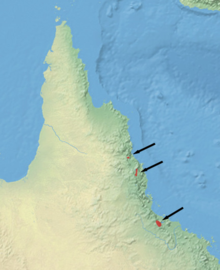Northern Brush Rat Kangaroo
| Northern Brush Rat Kangaroo | ||||||||||||
|---|---|---|---|---|---|---|---|---|---|---|---|---|
| Systematics | ||||||||||||
|
||||||||||||
| Scientific name | ||||||||||||
| Bettongia tropica | ||||||||||||
| Wakefield , 1967 |
The northern brush rat kangaroo ( Bettongia tropica ) is a marsupial from the rat kangaroo family (Potoroidae) that occurs in north-eastern Queensland on some small, isolated ridges and plateaus.
features
The northern brush rat kangaroo reaches a head body length of 29.5 to 43 cm, has a 27 to 35 cm long tail and weighs 0.9 to 1.4 kg. It is colored gray, sometimes with whitish hair tips. The belly is light gray or whitish. The limbs are lighter than the back. Some specimens have dark circles under the eyes. The rear part of the tail with longer hair is dark, the tip of the tail is white in some specimens.
habitat
The northern brush rat kangaroo occurs in northeast Queensland at heights of 400 to 1200 meters on some small, isolated mountain ranges and high plateaus with granite floors. These are the west slope of the Lamb Range, the west of the Mt Carbine Plateau, and the Coane Range. A population on the Mt Windsor plateau was last confirmed in 2003. The entire area inhabited by the northern brush rat kangaroo is less than 200 km². Most animals live above 800 meters. The habitat lies on the western edge of the rainforest between rainforest and forest savannah and consists of high wet forests, which are dominated by Eucalyptus grandis and Eucalyptus resinifera , and open dry forests of medium height, in which Corymbia citriodora and Corymbia platyphylla are the most important woody plants. The forest floors are covered with grass.
Way of life
The animals are solitary and nocturnal. The area used by a single animal has a size of 19 to 138 hectares. The territories of the males are larger than those of the females. The territories of the animals overlap. They spend the day in well camouflaged nests in shallow pits, bushes or under fallen tree trunks. The oval nests only have one opening. An individual can have up to three nests in its territory.
nutrition
The species feeds mainly on truffle-like mushrooms that grow underground and are dug up with their front paws. Mushrooms make up 30 to more than 60% of their diet. It also eats roots, tubers, rhizomes, seeds and invertebrates.
Reproduction
Females have a single cub per birth and give birth up to three times a year. The gestation period is 20 to 23 days. After birth, the young animal remains in the pouch for about 3.5 months and is weaned at 5.5 to 6 months of age. Females become sexually mature at 10 months of age and males are 15 months old.
status
The species is classified as Endangered by the IUCN . One of the main reasons for the decline of the species is the stalking by introduced predators such as red foxes and house cats , as well as the increasing drought, which makes their main food, the mushrooms, less common. At the moment there are no more red foxes in the distribution area of the northern brush rat kangaroo.
supporting documents
- ↑ a b c d e f g Mark Eldridge & Greta Frankham: Family Potoroidae (Bettongs and Potoroos). Page 627 in Don E. Wilson , Russell A. Mittermeier : Handbook of the Mammals of the World - Volume 5. Monotremes and Marsupials. Lynx Editions, 2015, ISBN 978-84-96553-99-6
- ↑ a b c d Bettongia tropica in the endangered Red List species the IUCN 2016 Posted by: Burbidge, AA & Woinarski, J., 2012. Accessed March 15, 2018th
